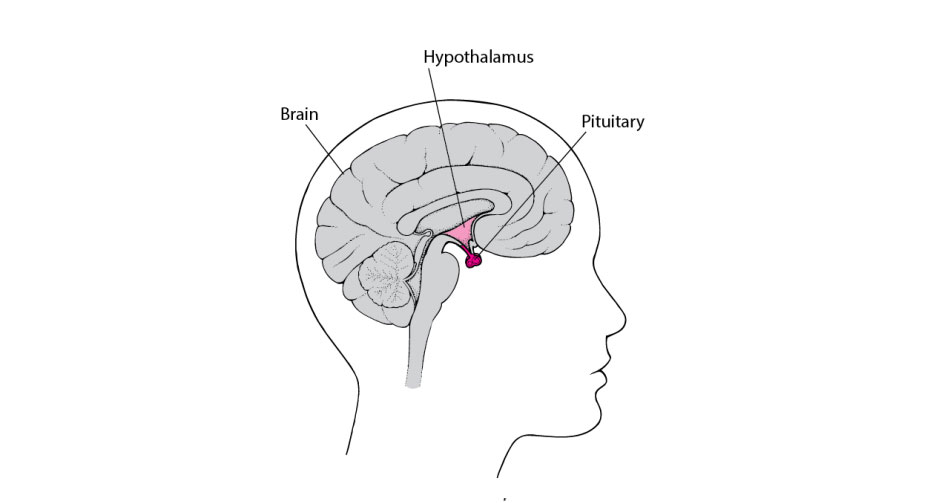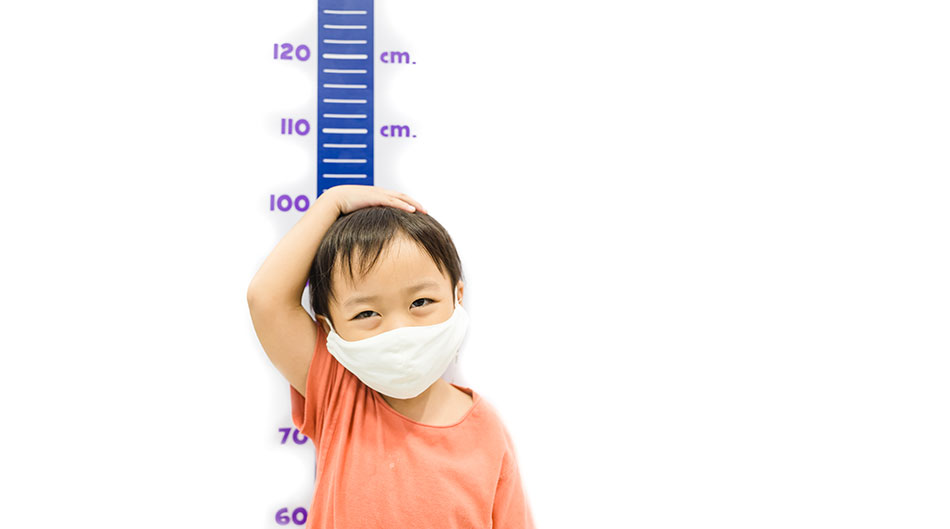Table of contents
- WHAT IS GROWTH HORMONE DEFICIENCY?
- HOW FREQUENT IS GROWTH HORMONE DEFICIENCY?
- WHAT CAUSES GROWTH HORMONE DEFICIENCY?
- WHAT ARE THE SIGNS AND SYMPTOMS OF GROWTH HORMONE DEFICIENCY?
- HOW DO YOU DEFINE “NORMAL” GROWTH?
- HOW IS GROWTH HORMONE DEFICIENCY DIAGNOSED?
- WHEN SHOULD BE SCREENED FOR GROWTH HORMONE DEFICIENCY?
- HOW IS GROWTH HORMONE DEFICIENCY TREATED?
- HOW IS THE DOSE OF GROWTH HORMONE DETERMINED?
- WHAT ARE THE SIDE EFFECTS OF GROWTH HORMONE TREATMENT?
- WHAT IS THE PROGNOSIS FOR GROWTH HORMONE DEFICIENCY?
WHAT IS GROWTH HORMONE DEFICIENCY?
Growth hormone deficiency is a rare cause of growth failure in which the child does not make enough growth hormone to grow normally. Growth hormone is one of several hormones made by the pituitary gland, which is located near the base of the brain and attached to the hypothalamus (a part of the brain that helps to regulate the pituitary gland).
If the pituitary gland is lacking in multiple pituitary hormones, the condition is called hypopituitarism.

HOW FREQUENT IS GROWTH HORMONE DEFICIENCY?
Estimates vary, but it is rare. The incidence is less than 1 in 3000 to 1 in 10,000 children.
WHAT CAUSES GROWTH HORMONE DEFICIENCY?
There are many causes of growth hormone deficiency, most of which are present at birth (congenital) but may take several years to become apparent or it can develop later (acquired).
Congenital causes include genetic or structural abnormalities of the development of the pituitary gland and surrounding structures, while acquired causes, which are much less common, can include head trauma, infection, tumour, or radiation.
In fact, the most common cause of growth hormone deficiency alone is idiopathic. This means that we do not find the causes of growth hormone deficiency in children after all tests done.
WHAT ARE THE SIGNS AND SYMPTOMS OF GROWTH HORMONE DEFICIENCY?
Children with growth hormone deficiency are usually much shorter than their peers (that is, well below the 3rd percentile line) and over time, they tend to drop farther and farther below the normal range. It is important to note that growth hormone-deficient children are usually not underweight for their height; in many cases, they are on the pudgy side, especially around the stomach. Other symptoms include very small penis in newborn males, delay in tooth development, impaired hair growth and delayed puberty.
Growth hormone deficiency has no effect on a child’s intelligence.
HOW DO YOU DEFINE “NORMAL” GROWTH?
Growth rates vary considerably from child to child. But measured in height, average ‘normal’ growth is often described as:
- 0-12 months: about 25 cm a year
- 1-4 years: about 10 cm a year
- 4 years to puberty: about 5 to 6 cm a year.
If your child is less than the 3rd percentile in height for a child of his age, that can be a red flag for growth hormone deficiency.
HOW IS GROWTH HORMONE DEFICIENCY DIAGNOSED?
Evaluation of a child with short stature and slow growth pattern may include a bone age X-ray (X-ray of the left wrist and hand) and various laboratory screening tests. The diagnosis of growth hormone deficiency cannot be made on a single random growth hormone level, because growth hormone is secreted in pulses, mostly overnight. At other times, levels may be undetectable.
The diagnosis for growth hormone deficiency is not based on Insulin-like Growth Factor 1 (IGF-1) alone because IGF-1 usually is normal in most children growth hormone deficiency, and usually only low in cases of severe growth hormone deficiency.
A more accurate but still imperfect way to diagnose growth hormone deficiency is a growth hormone stimulation test. In this test, your child has blood drawn for about 2 to 3 hours after being given medications to increase growth hormone release. If the child does not produce enough growth hormone after this stimulation, then the child is diagnosed with growth hormone deficiency. However, growth hormone stimulation tests can over diagnose growth hormone deficiency. Growth hormone stimulation tests vary and are complicated, so they are usually performed under the guidance of a paediatric endocrinologist.
Usually, other tests to check the pituitary gland or MRI to evaluate the brain are performed when treatment is considered.
WHEN SHOULD BE SCREENED FOR GROWTH HORMONE DEFICIENCY?
The time considered appropriated to screen growth hormone deficiency in children with short stature, is from 3 years old to pre-puberty because pubertal progress makes it impossible to increase height even with growth hormone treatment.
HOW IS GROWTH HORMONE DEFICIENCY TREATED?
The treatment for growth hormone deficiency is the administration of recombinant human growth hormone by subcutaneous injection (under the skin) once a day. The paediatric endocrinologist calculates the initial dose based on weight, and then bases the dose on the patient’s response and puberty.
The parent is instructed on how to administer the growth hormone to the child at home, rotating injection sites among the arms, legs, buttocks, and abdomen (umbilical region). The length of growth hormone treatment depends on how well the child’s height responds to growth hormone injections and how puberty affects the growth. Usually, the child is on growth hormone injections until growth is complete.
HOW IS THE DOSE OF GROWTH HORMONE DETERMINED?
The paediatric endocrinologist calculates the initial dose based on weight and condition being treated. At later visits, the doctor will change the dose for effect and pubertal stage and sometimes based on IGF-1 blood test results. The length of growth hormone treatment depends on how well the child’s height responds to growth hormone injections and how puberty affects growth.
WHAT ARE THE SIDE EFFECTS OF GROWTH HORMONE TREATMENT?
Treatment with human growth hormone is safe and effective. Few children experience side effects from growth hormone.
Side effects that have been described include headaches, hip problems, and issues at the injection site. To avoid scarring, you should place the injections at different sites. However, side effects are generally rare.

WHAT IS THE PROGNOSIS FOR GROWTH HORMONE DEFICIENCY?
Growth hormone usually results in an increase in height for growth hormone-deficient individuals, as long as the growth plates have not fused.
The reason for the growth hormone deficiency should be understood, and it is important to re-check for growth hormone deficiency because these children have a greater risk of cardiovascular and metabolic disease if they are still growth hormone deficient in adulthood.



